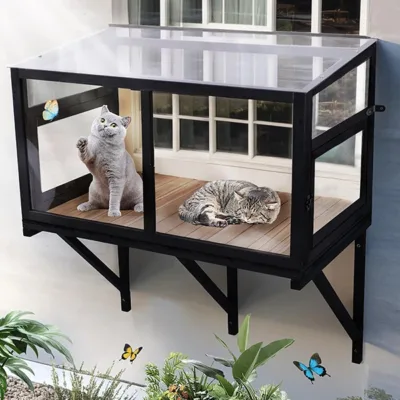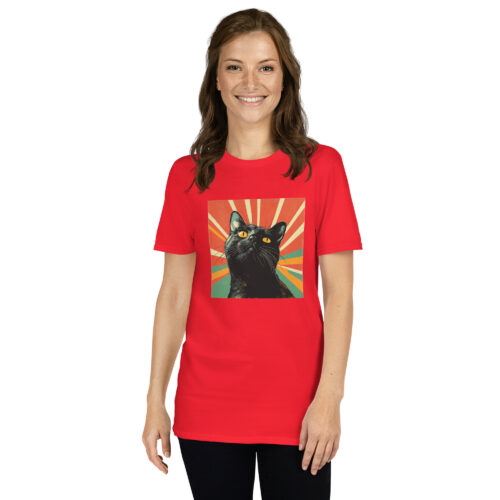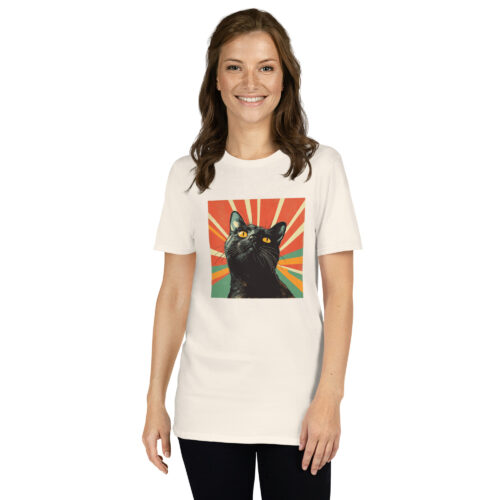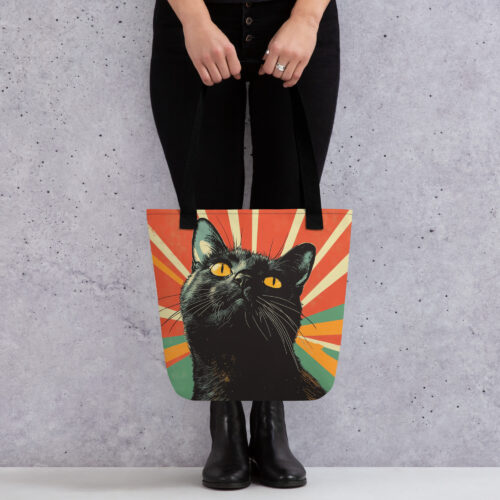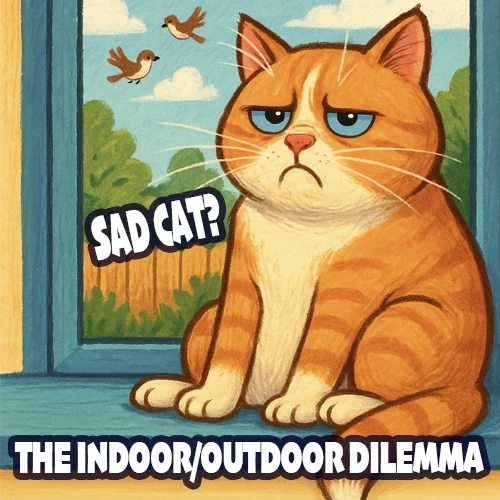
The Indoor/Outdoor Dilemma: Cat-Safe Compromises for Nature-Loving Felines
Table of Contents
Every cat owner knows the look. Your cat sits by the window, nose pressed against the glass, watching birds or swaying leaves with laser focus. That little chittering sound they make? Pure longing. They want out there, and it’s written all over their face.
But here’s the problem: outdoor cats live significantly shorter lives than indoor ones. We’re talking about a drop from 13-17 years down to just 2-5 years on average. Cars, predators, diseases, toxic substances—the outdoor world is full of dangers that can cut a cat’s life tragically short.
So what’s a caring cat parent supposed to do? Ignore those pleading eyes? Pretend they don’t notice their feline friend spending hours staring longingly at the great outdoors?
The good news is this doesn’t have to be an all-or-nothing decision. While catios have become popular solutions, they’re not practical for everyone. Rental restrictions, limited space, or tight budgets can make them impossible. Fortunately, there are plenty of other ways to give indoor cats a taste of nature without the risks.
Quick Comparison: Cat-Safe Outdoor Solutions
| Solution | Best For | Space Needed | Cost | Safety Level |
|---|---|---|---|---|
| Supervised Yard Time | Cats who enjoy exploration | Any outdoor space | Low (harness only) | High |
| Window Box Gardens | Window watchers | Window sill space | Medium | High |
| Balcony Modifications | Apartment dwellers | Small balcony | Medium-High | Medium-High |
| Indoor Plant Gardens | All indoor cats | Floor/shelf space | Low-Medium | High |
| Tech Solutions | Tech-savvy owners | Minimal | High | High |
Why Cats Crave the Outdoors
Understanding why cats are drawn to outdoor spaces helps us find better solutions. Domestic cats aren’t that far removed from their wild ancestors. Their brains are still hardwired for hunting, territorial patrol, and processing complex sensory information that only outdoor environments provide.
When your cat gets excited watching birds through the window, their hunting instincts are firing on all cylinders. All those scents drifting in through door cracks? That’s information they desperately want to investigate. The feeling of grass, dirt, or bark under their paws? These are textures their bodies are designed to experience.
Indoor environments, no matter how comfortable, simply can’t match the sensory richness of outdoor spaces. This sensory deprivation often leads to behavioral problems—destructive scratching, excessive vocalization, or general restlessness. These aren’t signs of a “bad” cat; they’re symptoms of an understimulated one.
The encouraging news is that you don’t need to recreate an entire wilderness. Small additions of outdoor elements can make a surprisingly big difference in your cat’s contentment level.
Supervised Outdoor Adventures
The most direct approach is supervised outdoor time. This gives your cat immediate access to real outdoor experiences while keeping them completely safe under your watchful eye.
Starting Slowly
Don’t rush the process. Cats who’ve lived indoors their entire lives can easily become overwhelmed by sudden exposure to outdoor stimuli. Begin with very brief sessions—perhaps just 10-15 minutes—and gradually extend the time as your cat grows comfortable.
Choose your timing carefully. Early morning and late afternoon typically offer the best combination of comfortable temperatures and interesting wildlife activity. Avoid windy days initially, as the constant movement and sound can overstimulate nervous cats.
Essential Safety Measures
Before venturing outside, thoroughly cat-proof your space. Research every plant in your yard—common favorites like lilies, tulips, and azaleas can be toxic or fatal to cats. Check fencing for gaps or weak spots, and remove access to fertilizers, pesticides, or other chemicals.
Consider investing in a well-fitted harness and leash, even for enclosed areas. While many cats initially resist harnesses, patient training usually pays off. The harness provides immediate control if something startles your cat or if they attempt to explore beyond safe boundaries.
Managing Expectations
Don’t expect constant action during outdoor sessions. Many cats prefer to find one comfortable spot and simply observe their surroundings. This might look boring to humans, but cats are processing an incredible amount of sensory information that indoor environments can’t provide. They’re cataloging scents, tracking sounds, and visually following movement in ways that provide deep mental stimulation.
Always bring familiar items outside—a favorite blanket or their carrier with the door open creates a safe retreat if they feel overwhelmed.
Window Box Gardens
When supervised outdoor time isn’t practical, window box gardens bring outdoor elements directly to your cat’s favorite observation posts.
Location Matters
Choose windows that receive good natural light without harsh, all-day sun exposure. Your cat should be able to observe comfortably without dealing with excessive heat or glare. Consider the indoor viewing angle too—position gardens where your cat can easily access them from their preferred perches.
Ensure your window can support the weight of soil, plants, and water. Window boxes become surprisingly heavy, especially after watering.
Smart Plant Choices
Research is crucial here since cats will likely investigate everything you grow. Stick exclusively to cat-safe options. Cat grass (wheat grass or oat grass) is an obvious choice that most cats genuinely enjoy munching.
Spider plants are excellent for beginners—they’re nearly indestructible and create fascinating movement in breezes. Their long, arching leaves provide visual interest that can captivate cats for hours.
Catnip and catmint are natural choices, though be prepared for enthusiastic responses. Some cats become so excited by fresh catnip that they might damage the plants in their enthusiasm.
For attracting birds and adding color, consider sunflowers, zinnias, or marigolds. These are safe for cats and provide the kind of wildlife activity that makes window watching endlessly entertaining.
Seasonal Considerations
In colder climates, plan for winter care. You can move boxes indoors and supplement with grow lights, or choose cold-hardy plants that survive temperature drops. Creating seasonal displays—spring herbs, summer flowers, autumn grasses—keeps the view fresh and interesting year-round.
Balcony Solutions for Apartment Living
Apartment dwellers shouldn’t feel excluded from providing outdoor experiences. Even small balconies can become cat-friendly spaces with proper safety modifications.
Critical Safety Updates
High-rise syndrome—cats falling from elevated spaces—is a real and serious concern. Cats can misjudge distances even from relatively low heights. If your balcony railings have gaps, install clear acrylic panels or mesh screening to create secure barriers that don’t obstruct views.
For balconies with horizontal railings that might tempt cats to walk along them like tightropes, add shelving or platforms below railing level to provide safer perching alternatives.
Maximizing Limited Space
Small balconies require vertical thinking. Wall-mounted shelves create climbing opportunities and multiple observation levels. Hanging planters add greenery without consuming precious floor space while creating movement and shadows that cats find engaging.
Ensure all mounted elements are extremely secure—cats jump onto things without warning, and safety margins are essential.
Weather Protection
Balconies face full weather exposure. Create sheltered areas where cats can retreat during wind, rain, or intense sun. A small covered bed or cat tent in one corner provides both weather protection and the sense of security that many cats need in open spaces.
Pay attention to surface temperatures, especially in summer. Metal railings and concrete floors can become uncomfortably hot, so provide insulated surfaces where cats can rest comfortably.
Indoor Nature Solutions
Sometimes the most practical approach involves bringing outdoor elements inside rather than taking cats outside.
Vertical Gardens
Living walls or vertical gardens can transform boring indoor walls into engaging natural displays. Use wall-mounted planters to create layers of cat-safe plants at varying heights. Position these near windows where natural light supports plant growth while cats can observe both indoor gardens and outdoor views simultaneously.
Moveable Container Gardens
Portable gardens using large planters offer flexibility that permanent installations can’t match. Plant cat grass, safe herbs like cilantro and parsley, and small flowering plants in attractive containers that can be repositioned around your home or even moved outside during pleasant weather.
Sensory Enhancements
Don’t overlook non-visual elements. Playing recordings of bird songs, rustling leaves, or gentle rain provides auditory stimulation that mimics outdoor experiences. Some cats respond well to nature documentaries designed specifically for pets.
For scent enrichment, incorporate small amounts of dried catnip or silvervine into container gardens. Not all cats respond to catnip, but most find silvervine appealing.
Technology-Enhanced Solutions
Modern technology offers interesting supplements to traditional approaches.
Programmable bird feeders positioned outside windows create scheduled wildlife viewing. Some models include cameras for observing bird activity remotely. Weather-resistant outdoor cameras let cats “patrol” yard spaces from indoor safety, with motion activation capturing wildlife activity during off-hours.
Small fountains or water features attract birds while creating sounds many cats find soothing. App-controlled versions allow you to vary operation times, adding unpredictability to your cat’s viewing experience.
Universal Safety Guidelines
Regardless of your chosen approach, certain safety principles apply universally.
Ensure vaccinations are current before any outdoor exposure. Discuss parasite prevention with your veterinarian—fleas, ticks, and intestinal parasites remain concerns even with limited outdoor contact.
Always have emergency plans for quickly bringing cats inside if needed. Practice name recognition so cats respond reliably to your voice, and keep carriers easily accessible during outdoor sessions.
Learn to recognize overheating or stress signs. Cats regulate body temperature less effectively than dogs, and excitement might mask early heat stress symptoms.
Stay aware of neighborhood hazards like construction areas, recently treated lawns, or spaces where outdoor cats mark territory. Even seemingly safe areas may harbor hidden dangers.
Building Your Approach
Start with one or two solutions that best fit your living situation and your cat’s personality. Some cats adapt quickly to new experiences while others need weeks or months to feel comfortable.
Pay attention to your cat’s specific preferences. Some cats are primarily interested in visual stimulation from bird watching, others crave tactile experiences with different surfaces, and still others are most engaged by new scents. Use these observations to guide your solution choices.
Remember that modest changes can significantly impact your cat’s quality of life. Simple window gardens or brief supervised outdoor sessions often provide the environmental enrichment that keeps indoor cats mentally and physically healthy.
Interactive Cat Outdoor Quiz
🐱 Find Your Cat's Perfect Outdoor Solution! 🌿
What's your living situation?
How much time can you dedicate to supervision?
What's your budget range?
What does your cat love most?
Indoor/Outdoor Cat Related Products
- [Durability & Sustainability] Crafted from ECOFLEX, a robust blend of recycled polymers and reclaimed wood fibers; designed to withstand the elements and resist moisture and odors, ensuring a durable shelter for your cat that's also kind to the planet
- [Comfort and Security] Features dual entry and exit points to cater to the instinctual needs of outdoor cats; includes vinyl door flaps to protect against the elements, ensuring a safe and cozy retreat.
- [Easy Assembly and Maintenance] Assembles quickly with no tools required; ECOFLEX material makes cleaning a breeze, ensuring a hygienic environment for your pets without the hassle.
- FRESH AIR FUN: Fully-enclosed playset is made of a nylon mesh – let’s in fresh air and gives you a good view of your pets at play whether it’s indoors or out! And the mesh is durable too, enough to withstand energetic play and the occasional claw climb.
- SPOTS TO HIDE AND SNOOZE: Included cubby cubes are rearrangeable inside the structure, giving you plenty of ways to keep your cats engaged by mixing it up over time. Each is a perfect spot to curl up and get away from the action.
- GREAT FOR MULTI-CAT HOMES: Have more than one cat at home? No problem at all! Kitty City mesh playsets offer plenty of room for several pets to run, hide and chase. It’s a relatively small footprint in your home for all the energy it will help them burn.
- 🐱Outdoor Cat Enclosures-INCLUDES ONE CAT TENT ,ONE CAT TUNNEL – The cat tent with two big zipper doors, The cat tunnel can link to cat tent by zipper for cats to play. Cat tent and cat tunnel can be used together or separately.
- 🐱Better for Outdoor - Mesh is breathable and give your indoor cats a breath of fresh air without worrying about them getting hurt or running away. keeps your pets closer to nature.
- 🐱Easy to Clean and Storage- The tent and tunnel were made by mesh and waterproof oxford. they are easy clean-up. And there is lightweight & poratable design storage bag for travel. Perfect for your backyard or even your porch, balcony, or deck.
- 【BEACH STYLE DESIGN】Inspired by classic beach chairs, this outdoor cat bed is both stylish and comfortable. It's perfect for cats who love to bask in the sun, providing a cozy, relaxing place that's like a mini sunlounger.
- 【COOLING CAT HAMMOCK CHAIR】The water-fillable cat cooling mat provides a refreshing cooling effect, perfect for hot weather. This pet cooling mat helps your cat stay comfortable and relaxed, even on warm summer days.
- 【ELEVATED DESIGN】This outdoor cat bed features a hanging design that ensures good ventilation, allowing your pet to rest or sleep away from hot, cold, or dirty floors.
Finding the Right Balance
The indoor/outdoor dilemma doesn’t require choosing between safety and satisfaction. Creative solutions let you provide meaningful outdoor experiences while maintaining the security that indoor living offers.
Whether through supervised outdoor time, window gardens, balcony modifications, or bringing nature indoors, you’re addressing fundamental feline needs for environmental stimulation. These experiences engage natural instincts and provide mental enrichment that contributes significantly to overall wellbeing.
The key is finding sustainable solutions that work for both you and your cat. Start with manageable approaches, consistently prioritize safety, and pay attention to what your cat enjoys most. With patience and creativity, you can create satisfying compromises that honor your cat’s wild instincts while keeping them safe and secure.
What outdoor solutions have worked best for your indoor cat? Share your experiences and creative ideas in the comments below!
Loved this post? Explore more helpful cat care tips on our cat blog and join our community of cat lovers to share stories and advice!
Last update on 2025-08-15 / Affiliate links / Images from Amazon Product Advertising API
Disclosure: This post contains affiliate links. If you purchase through these links, we may earn a commission at no extra cost to you.


